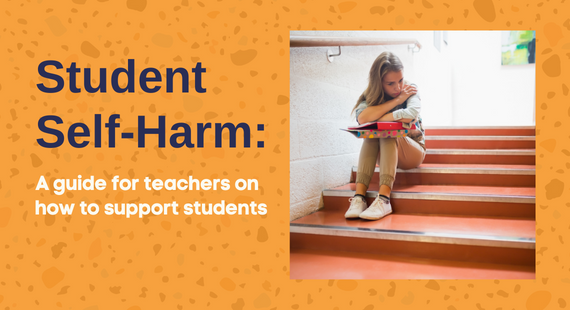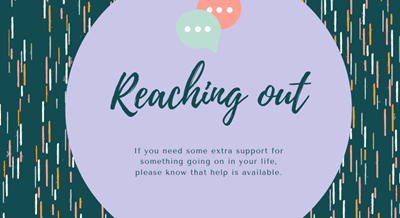
See some expert advice for teachers to help support students who may be engaging in self-harming behaviours.
Did you know that the adolescent brain is still under development and is different to a fully developed brain in adults? Based on the stage of their brain development, adolescents can be more likely to act on impulse and can get involved in or engage in dangerous or risky behaviours. Adolescents are still learning learned responses and they can also be less likely to think before they act, consider potential consequence of their actions, or modify their dangerous or inappropriate behaviours.
What we mean by self-harm
Self-harm can take many different forms and can be difficult to define. There are several different definitions: these can include any act of self-poisoning or self-injury carried out by an individual, regardless of motivation. Studies show that about one in three people who self-harm the first time will self-harm again.
While there are no 100% warnings signs that a student is engaging in self-harm, some common characteristics can include:
- a strong dislike for themselves
- a background of sexual or physical abuse
- experiencing uncomfortable or distressing emotions, such as anger, guilt, shame, or helplessness.
People who self-harm have been described as using self-harm as a way of dealing with these feelings and as a way of managing them.
Key warning signs that someone may be self-harming
Some people who self-harm can go to great lengths to conceal their injuries. Less than 12% of those who engage in self-harming behaviour will present for medical attention, so it can be hard to know if someone is self-harming.
People who self-harm can seem withdrawn or depressed. You may notice cuts or bruises that can be accompanied by excuses that do not seem to fit. Many people who self-injure, can cut themselves and may wear long sleeves to conceal this. School pupils who self-harm may look for excuses not to have to wear shorts or short sleeves and therefore may avoid activities like PE or swimming. It’s important to keep an eye on younger children who have a history of abuse.
What to do if you suspect self-harming behaviours
Teachers play such an important role for a student who might be self-harming. Teachers are often the first point of contact for a lot of young people; remember, you can make a tremendous difference to them.
Don’t ignore anything concerning; if your gut instinct is telling you something around a student, follow up on it.
If you suspect a student is self-harming, try to talk with them and see what information they will give you.
Some steps to take include:
- telling someone: pass this information on to a designated person and parent or guardian, and tell them about your suspicions
- encouraging the student to look for help: try and explain to the student that there are supports that can help them to manage their emotions in a more positive way
- avoid telling them you can keep this a secret: it’s important that you don’t promise to not pass this information along
- being aware of signs: recognising the warning signs and knowing what to do to help is key to prevention.
It can be difficult to prepare for a conversation around self-harm with student. We’ve compiled some tips to help you with your next steps.
Check in with yourself first
This can be very upsetting, and it can be difficult to know how to approach it or what to do. First, take a deep breath; it’s not uncommon to initially feel emotions such as fear or anxiety around speaking to a student who you suspect is self-harming.
Prepare yourself for an open, non-judgmental conversation
Approaching the young person in a calm and non-judgmental manner where your goal is just to listen can be one of the most powerful things you do. Let the young person know you have noticed a change in their behaviour and be open about your concerns, while remaining calm, non-judgmental and understanding.
Be direct with the student
A student potentially might be more confident if you ask in a direct way and are able to hear that answer. For example, you can say “I have noticed that you have become angrier, withdrawn, sad and I’m wondering if things are difficult for you at the moment?”. If you have an explicit concern, you could move on to more specific questions such as “I’ve also noticed that you have got some scars or have been covering up and I know that sometimes this can sometimes be a sign that someone has harmed themselves. Can I ask if you have self-harmed?”.
Build trust and offer reassurance if a disclosure is made
You may be the first person that they have disclosed this to. Stay calm and non-judgmental; this approach will help to build trust.
Reassure them that they have done the right thing in being open with you and that you will help to get them support; this can help to self-regulate the student.
Remember, listening to the student can be the most powerful gift you can give your students at this point. Remaining constant and supportive will have a hugely positive impact on the young person’s wellbeing.
It may be difficult for them to hear “just stop doing it”. They may interpret their self-harm as their only coping mechanism at that time and it is usually a work in progress for a young person to change this behaviour and stop self harming.
Follow school policy and safeguarding protocols
Check your school’s policy on self-harm presentations and raise the matter to a designated key member of staff as soon as you can, making the student aware that you are doing this. If your school does not have a policy, consider developing one; it’s going to support you as a team in being able to deal with these kinds of presentations. Consider having a staff member who is a designated person for self-harm presentation, which will support the team and the process also. There is a guidance document, Support for Guidance Counsellors and Schools around Student Disclosures of Suicide and/or Self-Harm, available; find the guide here.
Share your concerns with key people
You must share this information with the parent or guardian (unless there is a child safety concern in which you will have to tell a social worker). It’s important not make promises you can’t keep to the young person regarding things such as confidentiality. Be clear with the young person why you are doing this and if you can, give them choices about how you might tell their parent or guardian - make it as collaborative as possible. Further professional support outside the school is usually necessary, contact a GP, Child and Adolescent Mental Health Services (CAMHS), or Pieta.
The impact of self-harm on other students
It can be difficult for other students in your class when a friend or schoolmate is self-harming. Some guidance on managing the impact for other students is shared below.
Monitor reactions and don’t panic
Keep a close eye on the other students who know about self-harm - one students’ self-harming behaviour can sometimes impact other students also. Self-harm can be “contagious” in social groups. If more than one student has self-harmed, it’s important not to panic.
Reassure your students
If a student comes to you with concerns about another student who is self-harming, reassure them that telling you was the right thing to do and that they have been a good friend. Offer them the opportunity to speak to the school guidance councillor if possible; doing so can have an impact on a friend.
Raise awareness of healthy coping mechanisms
Raise awareness of how students can get help when they are struggling with difficult emotions. It’s advised to provide support separately for young people who are self-harming. A talk to the school on resilience and help-seeking behaviour is more beneficial than a talk around self-harming. This is seen as better practice as the subject of self-harm can be triggering for those who do or who have stopped.
Teacher self-care
It’s important for teachers to recognise that talking about self-harm can be a difficult and upsetting thing to talk to somebody about. Self-care is important during this time.
Take stock of your emotions. Be honest with yourself about your own emotions - it is common to experience sadness, shock, fear, disgust, frustration and helplessness. Give yourself time after the conversation to check in with yourself.
Talk about how you are feeling. Discuss your feelings with colleagues or a principal, seek support, and make sure that you prioritise your own self-care.
Finally, don’t blame yourself if you miss the signs a student is engaging in self-harm in your classroom. There is no way to see everything that is happening all of the time. Know that you are doing your best.


